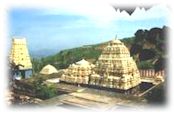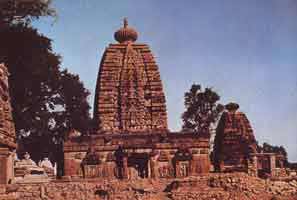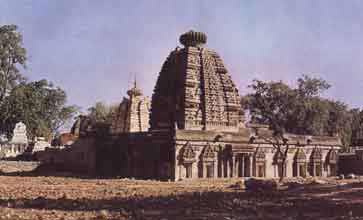|

Temples The State of
Andhra Pradesh abounds in archeological remains and religious monuments.
The Satavahanas of the 1st century AD left behind them many works of art,
the remains of which are seen at Amaravati near Guntur. The Ikshvakus
succeeded the Satavahanas and the monuments left behind by them were
discovered at excavations at Nagarjunakonda.Some of the best known Budhist
monuments of Andhra Pradesh such as the Mahastupa and some Hindu temples
were found in these excavations. Tirupati  Tirupati
is one of the important pilgrim centres in India. It is famous for the
shrine of the seven hills, dedicated to Lord Venkateshwara, alsoknown as
Balaji the temple of Tirumala (13 km). Tirupati
is one of the important pilgrim centres in India. It is famous for the
shrine of the seven hills, dedicated to Lord Venkateshwara, alsoknown as
Balaji the temple of Tirumala (13 km).
Other Temples at Tirupati:
Govindarajaswamy Temple, Kapilathiraham, Kodandaraswamy Temple, Padmavati Simhachalam The 11th century Varaha Lakshminarasimha
Temple is in the picturesque Simhachalam hill range, 244 metres above sea
level. Puttaparthy
 Prasanthi
Nilayam:Puttaparthi was described a few years ago by a western writer
as a place, ‘a few footsteps away from stone age’. Today, however that
very hamlet holds in its heart ‘Prasanthi Nilayam’ or Abode of the
Highest Peace, one of the most important pilgrim centres of India and the
world. This is the abode of Bhagwan Sri Sathya Sai Baba, 73, perhaps
India’s most known saint of modern times.Sri Sathya Sai Baba, the most
colourful and multifaceted prophet, modern India has produced, is believed
to be the very avatar (incarnation) of love and the voice of one’s own
innermost heart speaking to each individual externally. The teachings of
the Baba are based on the famous ‘five props’ of Sathya (truth),
Dharma (righteousness) Santhi (peace), Prema (universal love) and Ahimsa
(non violence). Prasanthi Nilayam, over the years, has attracted people
from all over then world. The Ashram has a code of conduct which every
visitor should follow. The Ashram also has museums, stadiums, educational
institutions, the Sai Space Theatre etc. The 23rd of November
is celebrated with great joy and enthusiasm by the devotees of Baba at the
Prasanthi Nilayam. Over a million people gather here on the occasion of
the Baba’s birthday. The atmosphere around the Ashram is undeniably
peaceful, and the growth of such a vibrant community in this once
forgotten backward area is not a small miracle. Prasanthi
Nilayam:Puttaparthi was described a few years ago by a western writer
as a place, ‘a few footsteps away from stone age’. Today, however that
very hamlet holds in its heart ‘Prasanthi Nilayam’ or Abode of the
Highest Peace, one of the most important pilgrim centres of India and the
world. This is the abode of Bhagwan Sri Sathya Sai Baba, 73, perhaps
India’s most known saint of modern times.Sri Sathya Sai Baba, the most
colourful and multifaceted prophet, modern India has produced, is believed
to be the very avatar (incarnation) of love and the voice of one’s own
innermost heart speaking to each individual externally. The teachings of
the Baba are based on the famous ‘five props’ of Sathya (truth),
Dharma (righteousness) Santhi (peace), Prema (universal love) and Ahimsa
(non violence). Prasanthi Nilayam, over the years, has attracted people
from all over then world. The Ashram has a code of conduct which every
visitor should follow. The Ashram also has museums, stadiums, educational
institutions, the Sai Space Theatre etc. The 23rd of November
is celebrated with great joy and enthusiasm by the devotees of Baba at the
Prasanthi Nilayam. Over a million people gather here on the occasion of
the Baba’s birthday. The atmosphere around the Ashram is undeniably
peaceful, and the growth of such a vibrant community in this once
forgotten backward area is not a small miracle. Tempels
of Alampur Swarga
Brahma Temple : 
This important shrine seems to have
been constructed towards the end of the 7th century A.D. There is an inscription
above the dwarapalika image, which states that the shrine was constructed by
Lokaditya-Ela-Arasa, in honor of the queen of Vinayaditya, called Mahadevi. Like all other temples except the
Taraka Brahma, the Swarga Brahma is a hall temple. The shrine is at the end of
the rectangular hall, which is divided into a nave and side aisles by the use of
pillars connecting the passage. Like the Kumara Brahma, the Swarga Brahma also
has a porch. The panels on the outer walls carry relief figures of the Krishna
Lila, Animals, Garuda-nose faces and Matrumurti. The pattern of carving is the same as
on the Vishva Brahma temple. Although there had been relief carvings
in Aihole and Pattadakal, the pantheism here shows a passionate enthusiasm for
exaltation of human form to divine status. There are Pauranic scenes, loving
couples and flying spirits. And in the midst of these are the independent
realizations of the gods, by the release into a certain innocence and freer
interpretation of the icon beyond the manner of the Chalukyas in the west. One of the new dhyana mantras is a wall
sculpture entitled Lingodbhavamurti of Shiva, inset into a tall phallus, with
worshipping figures in a rectangular panel from which the lingam is carved. And a truncated figure shows the
remains of a dynamic sculpture of shiva as Tripurasuramharamurti. The mobility
of the carving skillfully releases energies into the universe with terrifying
violence. Another broken figure is a relief of
Gangavatarana, again as a demonstration of the Alampur sculptor's genius for
release of potential power of the gods. A similar sculpture of Shiva involved in
the Tandava dance is a heroic image. The frenzy of the movement is caught in the
ecstatic moment, by some Viswakarma, realizing himself through the expression of
muscular energies into the universal image of dance incarnate. Shiva is shown in another mood as he
stands, pensively, with the gracious bend of his body, almost supplicating
Parfait. The Mithuna couples show the sculptor's sensitiveness to tenderness
between the male and the female, through the evocation of desire lurking below
the surface of life and evoked here through the woman's shy withdrawal and the
man dragging her by the arm from the natural urge of seduction. The Swarga Brahma temple has a six
pillar porch on the east, the Puranghata pillars being decorated with amalkas.
There are horned dwarpals by the doorway. Ganga and Jamuna are symbolically
carved on the door-frame with the GarudaNaga motif above. The temple has a curvilinear sikhara of
the northern style, with a figure of dancing Shiva carved in the Chaitya window
of the Sukanasi. Top The Garuda Brahma Temple : 
Modeled on the Padma Brahma, this
temple is distinguished by elaborate carvings on the pillars inside the hall,
with the cool shadows secured for the extension of consciousness into the
non-sensuous realms of calm. Vishva Brahma Temple : 
Except that it has no porch, the plan
of the Vishva Brahma resembles the Swarga Brahma. The sculptures on the facade
are also similar, both in theme and execution, though the virtuosity has
disappeared because of the vandal's axe. Thus the figure of Trivikrama might
have been a magnificent carving when it was whole. Also, the Gangavatarana was
once a highly energetic sculpture. The Mithunas are also damaged. The floral
relief of makaras and birds with flying figures indicate the lyricism of desire
flowing through them from the springtime of the Chalukyan sensibility.
Top
|
|



